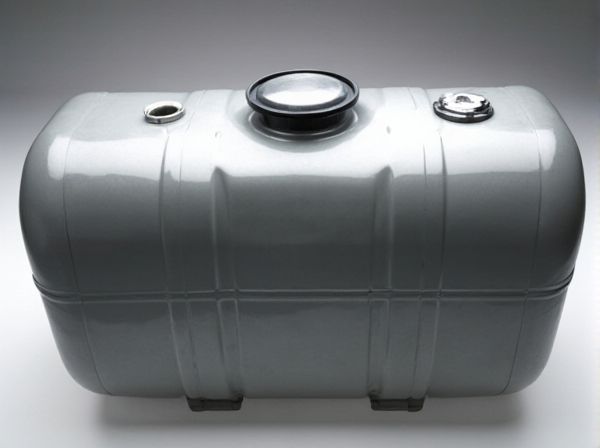
Photo illustration: Double-Walled Tank vs Single-Wall Tank
Double-walled tanks provide enhanced protection against leaks and environmental contamination compared to single-wall tanks, making them ideal for storing hazardous liquids. These tanks feature an inner and outer layer, allowing for spill detection and increased structural integrity. You benefit from greater safety and regulatory compliance when choosing double-walled tanks over single-wall options.
Table of Comparison
| Feature | Double-Walled Tank | Single-Wall Tank |
|---|---|---|
| Construction | Two layers: inner tank + outer shell | Single layer design |
| Leak Protection | High: Outer wall contains leaks | Low: Immediate risk if inner wall fails |
| Durability | Enhanced resistance to corrosion and damage | Standard resistance, more prone to wear |
| Fuel Containment | Superior containment, reducing spill risk | Basic containment, higher spill risk |
| Safety | Better protection against fuel leaks and fire hazards | Less protection, higher safety concerns |
| Cost | Higher initial cost | Lower upfront cost |
| Maintenance | Lower maintenance due to enhanced durability | May require frequent checks and repairs |
Understanding Double-Walled and Single-Wall Tanks
Double-walled tanks feature two layers of containment, providing enhanced protection against leaks and environmental contamination compared to single-wall tanks, which consist of only one layer. The secondary wall in double-walled tanks acts as a safeguard by capturing any leaks or spills, making them ideal for storing hazardous or environmentally sensitive liquids. Single-wall tanks are simpler and more cost-effective but lack this additional security, increasing the risk of accidental release and regulatory non-compliance in certain applications.
Construction and Design Differences
Double-walled tanks feature an inner tank encased by a secondary outer wall, creating a containment space that enhances leak detection and prevents environmental contamination, while single-wall tanks consist of a single layer offering less protection against leaks. The construction of double-walled tanks involves materials such as steel or high-density polyethylene with a sealed interstitial space, whereas single-wall tanks typically use a single layer of steel or fiberglass without secondary containment. Design differences emphasize safety and regulatory compliance for double-walled tanks, making them suitable for hazardous liquid storage, whereas single-wall tanks are common for non-hazardous substances where spill risks are lower.
Safety Features Comparison
Double-walled tanks offer enhanced safety by providing a secondary containment barrier that reduces the risk of leaks and environmental contamination compared to single-wall tanks. Single-wall tanks rely solely on their primary structure, making them more vulnerable to corrosion and damage that can lead to spills. Regulatory standards often favor double-walled designs for hazardous material storage due to their improved leak detection and spill prevention capabilities.
Environmental Impact and Leak Prevention
Double-walled tanks provide superior environmental protection by incorporating an outer barrier that captures leaks from the inner tank, significantly reducing soil and groundwater contamination risks compared to single-wall tanks. Single-wall tanks lack this secondary containment, making them more prone to undetected leaks that can result in hazardous spills and costly environmental remediation. Regulatory frameworks often mandate double-walled tanks for hazardous substances due to their enhanced leak prevention capabilities and reduced environmental impact.
Regulatory Compliance and Standards
Double-walled tanks offer enhanced regulatory compliance by meeting strict environmental protection standards such as EPA Spill Prevention, Control, and Countermeasure (SPCC) requirements and UL 142 certification, significantly reducing leak risks compared to single-wall tanks. Single-wall tanks often require secondary containment systems or additional safety measures to comply with regulations and prevent soil and groundwater contamination. Compliance with industry standards like API 650 and NFPA 30 is more readily achieved with double-walled tanks due to their superior leak detection and containment capabilities.
Installation Requirements and Considerations
Double-walled tanks require more complex installation procedures due to the need for secondary containment measures, including precise positioning to prevent leaks between walls and additional space for monitoring equipment. Single-wall tanks offer simpler installation with fewer regulatory constraints but lack built-in leak detection, necessitating supplementary containment solutions. Site-specific factors such as soil stability, local codes, and environmental impact assessments heavily influence the choice between double-walled and single-wall tank installations.
Maintenance and Inspection Needs
Double-walled tanks require more rigorous maintenance and inspection protocols due to their dual-layer design, which helps detect leaks early and prevent environmental contamination. Single-wall tanks typically undergo simpler inspection routines but pose higher risks of unnoticed leaks and corrosion, leading to potential costly repairs and regulatory penalties. Regular integrity testing, corrosion monitoring, and adherence to local regulations are critical for both tank types to ensure safe and compliant operation.
Cost Analysis: Initial Investment vs Long-Term Savings
Double-walled tanks typically require a higher initial investment due to their enhanced materials and construction complexity compared to single-wall tanks. Over time, the superior leak protection and reduced environmental risk of double-walled tanks lead to significant savings in maintenance, regulatory compliance, and potential contamination cleanup costs. Evaluating total cost of ownership reveals that double-walled tanks offer better long-term economic benefits despite a larger upfront expense.
Industry Applications and Use Cases
Double-walled tanks offer enhanced safety and environmental protection in industries handling hazardous liquids, such as chemical manufacturing, oil and gas, and wastewater treatment, by preventing leaks and contamination. Single-wall tanks are commonly used in less sensitive applications like food processing and agriculture where cost efficiency and simplicity are priorities. Choosing between double-walled and single-wall tanks depends on the regulatory requirements, risk of corrosive materials, and necessity for spill containment in specific industry use cases.
Choosing the Right Tank for Your Needs
Double-walled tanks provide enhanced protection against leaks and spills by incorporating a secondary containment layer, making them ideal for hazardous materials or environmentally sensitive areas. Single-wall tanks offer a cost-effective solution for non-hazardous storage but lack the additional safety features required for compliance with stricter regulations. Selecting the right tank depends on the stored substance, regulatory requirements, and site conditions to ensure safety and operational efficiency.
 caratoz.com
caratoz.com